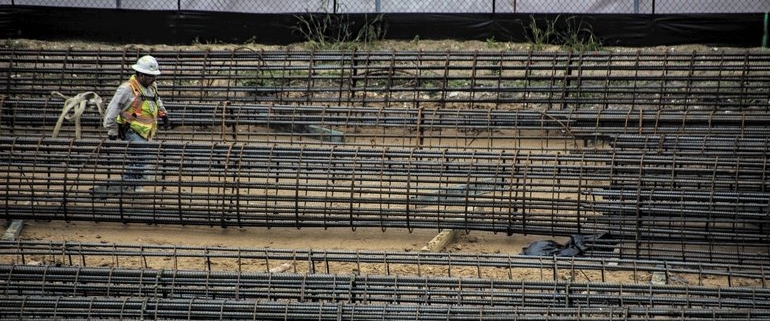The war for talent: How contractors battle for workers
By Robyn Griggs Lawrence | Originally posted on www.constructiondive.com
John Mingione, principal of New York City-based Omnibuild, has worn a lot of hats since he founded his construction management firm in 2003 — but never, until this year, has he needed a detective’s fedora. As Mingione doles out jobs to subcontractors because Omnibuild is short on workers, he’s keeping a close watch to ensure the subs can maintain adequate staffing.
“I keep my ear close to the ground, trying to spread the wealth around and not put too many eggs in one basket,” he said.

In Los Angeles, Landmark Construction founder Ezra Laniado — also struggling to attract labor — is working on his poker face. He has found “the easiest way, which is the hardest way” to get and keep workers on his jobsites is to pay them more, but he has to be careful not to appear too desperate or they’ll ask for even higher wages.
“It’s a delicate balance,” he said. “We have to be very foxy.”
The construction industry’s inability to attract and retain talent, a major problem for more than a decade, has escalated into a full-blown crisis since the start of the COVID-19 pandemic. With only 80% of the 1 million construction workers who lost their jobs at the start of lockdowns returning, according to CNN, Associated Builders and Contractors announced the industry needs to hire 430,000 workers this year and 1 million more over the next two years to keep pace with demand. Construction is competing for those workers with desperate companies from every other industry in a labor shortage Chamber of Commerce CEO Suzanne Clark called “a national economic emergency.”
Fighting for talent
Though exacerbated by the pandemic, the industry’s talent drain started long before anyone had heard of COVID-19. As contractors have been forced into ever-more creative methods of finding and holding onto workers, industry leaders have formed collectives to study and address the problem. With an aging workforce (the median age of construction workers is 41) and a monthly turnover rate of 5.2% compared with 3.6% over all industries, construction has some hurdles to overcome.

“It’s a war for talent. It’s really bad out there,” said Branka Minic, CEO of Building Talent Foundation (BTF), a coalition of the nation’s largest residential building companies that advances education, training and career progression for young and underrepresented workers. “Everybody is screaming for people, not only in our industry. We need to fight for every person and be much more agile in our efforts.”
When Minic took the helm of BTF two years ago, she set out to align education and training programs with the industry’s needs and partner with organizations that can help BTF reach new populations, including schools, churches, foster care agencies and community groups ranging from veterans to Girl Scouts.
“We’re definitely diversifying the industry,” Minic said. “That’s one of our goals, obviously, to open new sources of talented people and make sure they have good opportunities.”
Higher wages
Paying higher salaries would appear to be the easiest way out of this crisis, but that becomes more expensive every day. The reservation wage, the lowest average wage Americans without college degrees will accept for new jobs, has increased by 26% over the past year, to $29.56, according to the Federal Reserve Bank of New York. And this trend is far from over: a Willis Towers Watson survey found wage increases for production and manual labor workers rising from 2.5% this year to 2.8% in 2022.
Preferred Contractors Association Chief Marketing Officer Hadar Raz has seen construction companies raise salaries by as much as 10% in particularly hard-hit regions.
“All industries have common practices that work, and the construction industry has to first get to those,” Raz said. “A basic one is to start increasing salaries. That’s the first step.”
The next step, Raz said, is appealing to younger people by adopting worker-friendly practices common in other industries, including bonuses, flexible schedules and career training. “You can either give people a job or a career path. We need to show people this is a career and a profession, a trade they can always hold onto.”
What millennials want
Joe Flanagan, senior employment advisor at career matchmaker VelvetJobs, said more than 50% of millennials will remain in a job if they see potential career advancement, making training programs and reward systems a vital part of company structure. These programs, Flanagan said, “confirm to employees that they are valued for their contribution.”
Millennials won’t tolerate military-style hierarchies in which “the foreman is god and everyone does what he says,” said Carol Sigmond, a New York City-based partner in the construction practice group at law firm Greenspoon Marder. Younger workers are demanding a more collaborative approach, she said, “and it’s not so clear to me there’s not going to be some value in that.”
To attract younger workers, Sigmond said, contractors must stop treating construction as itinerate work. “The work is going to have to become steadier. The notion that people will work for nine months a year and spend three months sitting on a beach somewhere has to change. They can be training and prepping for the next year — but they must have steadier employment.”
“Construction, like any industry, pays people based on the value of the skills they bring to the table,” said Rolf Bax, chief human resources officer at career resource Resume.io. “It can be hard finding general laborers for sites because so many companies treat these people as disposable. If you make it known that people who want to learn new skills will be given an opportunity to do so, you will start to see more people applying.”
Attracting new workers
Younger workers are motivated less by money and more by what companies can do for them. They’re drawn to and stay with purpose-led companies with a human-centric approach, said Pat Wadors, chief talent officer at construction technology firm Procore Technologies and former senior vice president of LinkedIn’s Global Talent Organization.
Contractors need to get clear about their organizations’ purpose before creating what Wadors calls an “employee value proposition,” a promise to pay fair wages, treat everyone with respect and nurture an inclusive culture. “This creates clarity as you attract talent,” she said. “And employees will hold you accountable for that promise like never before.”

For Sacramento-based Otto Construction, that means focusing less on what skills people bring to the table and more on how their personality and work ethic would fit with the company’s culture of honesty, integrity and compassion. “Construction is great, but it’s not rocket science,” said CEO Allison Otto. “If you’re willing to learn and want to be part of our team, we’ll teach you how to do it. Our culture is so important. If we find someone who’s a good fit for it, we’ll mentor them and bring them up.”
“Culture is not something you can apply a dollar amount to — it’s not a health benefit,” said Laura Newbrough, human resources director at virtual design and construction company Zelus, which hires almost exclusively based on employee referrals and has a retention rate of more than 90%. “Culture is about leading and teaching and allowing people to learn on their own and try new things. It has always been the most important thing to me. I’m constantly checking in — how is the culture, how is the culture, what is a cultural threat?”

